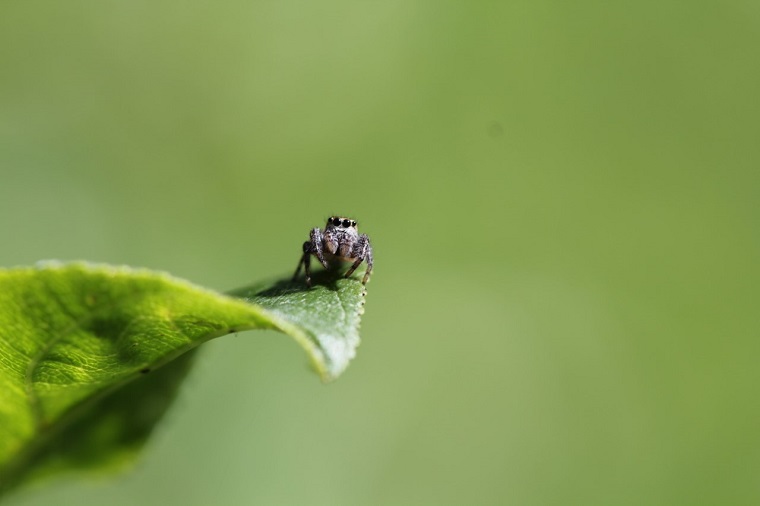Restoring Natural Habitat on Farmland Yields Big Biodiversity Payoff
By Caroline Reisiger
5 October 2021

Jumping spider (Phidippus sp.) resting on a leaf (photo by Aleksandra Dolezal)
Farmland has long dominated the rural Southern Ontario landscape, but you may have noticed that the farms of today look a lot different than they used to. Crop fields are getting progressively bigger, while non-cultivated areas such as hedgerows and riparian areas are shrinking – along with the arthropod biodiversity these areas support.
Conserving biodiversity and its resulting ecosystem services in agricultural areas has become a hot topic in recent years, with farmers growing increasingly concerned about the loss of insect pollinators and predators that help control crop pests.
Ecologists look at this topic more broadly, seeking to understand the complex factors that support a healthy balance of beneficial arthropod populations, and those that are considered pests.
“The fundamental question we grapple with is: why is the world green? Why don’t insects devastate plants completely?” says Aleksandra Dolezal, a PhD student in the Department of Integrative Biology.
“Ecologists have two main hypotheses to explain why this doesn’t happen: one has to do with bottom-up control (resource availability) and the other is top-down control (predators). I have always been interested in this topic and that's what brought me to this field of study."
Working with Dr. Andrew MacDougall, a professor of ecology, Dolezal designed and carried out a newly published study that shows even small areas of native tall grass prairie on farms can boost arthropod biodiversity and support a more balanced ecosystem.
The study looked at arthropod populations in crop, prairie and remnant forest habitat on 13 farms in Southern Ontario. All of the farms surveyed participate in ALUS, a community-based program that encourages farmers to designate a small part of their land as a non-crop natural habitat.
The researchers found that creating or maintaining non-crop habitat, including uncultivated pastures, hedgerows, forest remnants and restored prairie areas, increases overall farm biodiversity, particularly when it comes to beneficial insects. These habitats provide food and nesting resources for pollinators and predators throughout the year while the adjacent cultivated fields change seasonally.
Restored prairieland often occupied less than 10% of the farms studied but was found to provide the greatest benefit.
“These restored areas were small, so we wanted to see if they even made a difference,” explains Dolezal. “There were also concerns that restoring these areas might bring more pest species, not beneficials. We did not know if this habitat was a good enough quality for beneficials to stay.”
The data proved highly reassuring, however. With plants that can support a wide variety of arthropod families, prairie areas were home to 44% of all families and 66% of the beneficial families detected in the study.
Restored prairie habitat also had double the abundance of arthropods compared to crop fields or forests. Intriguingly, the researchers found increased abundance even in newly restored prairie habitat. This means that even though original remnant prairies are now mostly absent from the landscape, native arthropods have a remarkable ability to find newly created habitat and can colonize restored areas within one year of their creation.
Dolezal and MacDougall also compared the data they collected on farms with broad data from nearby natural and conservation areas, gathered from iNaturalist, an app that allows users to record observations of flora and fauna. Here, the team found another surprise.
“There was a difference of only 11 arthropod families between the two areas. There were 194 families recorded in the iNaturalist areas, while we found 183 families in the farmed areas,” says Dolezal. She attributes much of the diversity measured on farms to prairie-type habitat.
As the land used for agriculture increases, creating or maintaining high quality habitat within farmed areas will be critical to conserve biodiversity and the benefits - often called ecosystem services - that it generates.
This type of conservations efforts by farmers often goes unnoticed, says Dolezal.
“Ecosystem services are a public good but not a lot of people think about that. Farmers are putting in the time and effort to take some of their land out of production to make it more sustainable. I can’t do that because I live in the city.”
The study is an important step towards improving conservation policies and highlights the need to support farmers in creating more and higher quality refuge habitat on farms to increase agricultural sustainability.
This study was funded by the Canada First Research Excellence Fund and the Ontario Ministry of Agriculture, Food and Rural Affairs.
Read the full study in the journal Restoration Ecology.
Read about other CBS Research Highlights.